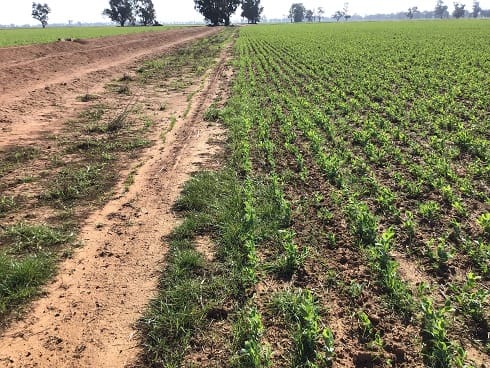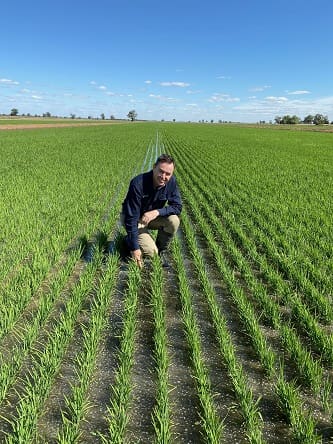
Field pea is a competitive legume crop that can reduce annual ryegrass germination in the paddock and halt encroachment from the crop borders.
Ask a WeedSmart Expert
THE best weed control comes from tactics that also bring other benefits to a farming system.
Sefton Agronomics principal agronomist in the Riverina, Greg Sefton, says multi-resistant annual ryegrass is becoming a major problem in irrigated systems.
“Herbicide resistance can move easily through irrigation areas, particularly when the control methods used on the supply channels are limited to just a few herbicides,” he said.

Sefton Agronomics principal agronomist in the Riverina, Greg Sefton, says legume cover cropping is providing effective control of multi-resistant annual ryegrass in irrigated systems.
“The ryegrass here is generally accepted to have resistance to glyphosate (Group 9 [M]), Group 1 [A] such as clethodim, Group 2 [B] and Group 3 [D], such as trifluralin. Growers are now relying heavily on Group 15 [K] products such as Sakura, and doing their best to rotate out of the problem.”
To regain control, Mr Sefton is working with growers to incorporate a multi-purpose fallow crop such as field pea into the system as a winter fallow clean with the added benefit of contributing biological nitrogen into the soil ahead of planting rice or wheat.
“A competitive pulse crop terminated at maximum biomass is an excellent way to reduce weed seed set,” he said.
“It is a cultural control that also enables the use of some herbicides that are rarely used in our system. Combining the herbicide and cultural methods in the WeedSmart Big 6 is an effective way to keep our cropping options open and to maximise the value of applied water.”
What is the best fit for the legume crop as a winter clean?
In brief: In the Riverina, the optimal place in the rotation is ahead of rice.
The details: Fields selected for rice production are usually bare fallowed for the preceding winter. The aim of the fallow is to control weeds and conserve soil moisture.
Some growers are having success with field pea sown in May as a winter cover crop then terminated for silage or as a brown manure in early September. This fits well with preventing seed set in annual ryegrass, including late germinating plants.
Field pea is a competitive legume and can suppress weed germination and growth when planted in the most competitive configuration possible with minimal soil disturbance and no gaps.
A knockdown treatment of glyphosate (Group 9 [M]), clopyralid (Group 4 [I]) and carfentrazone (Group G [14]) is applied at planting then a mix of pendimethalin (Group 3 [D]), clomazone (Group 13 [Q]) and paraquat (Group 22 [L]) is applied after an irrigation flush to initiate rice germination and prior to rice germination to knockdown both newly emerged barnyard grass (BYG) and persisting ryegrass. This provides a double knock on ryegrass whilst applying a pre-emergent herbicide for barnyard grass in the rice phase.
When implemented once every four or five years, with a diverse rotation of winter and summer crops in-between, growers can keep a lid on herbicide resistant annual ryegrass populations.
How do you manage weeds on the non-crop areas?
In brief: The same herbicide mix is applied to the whole paddock, including the weeds growing in the check banks.
The details: Weed seed, often carrying herbicide resistance genes, travels easily through irrigation systems and can colonise non-crop areas. Seed from these plants readily infests the cropping areas if not controlled effectively. The control measures used on non-crop zones are often limited to herbicide tactics, so it is important to make sure the herbicide is applied to maximum effect to prevent seed set.
Farm hygiene and physical removal of isolated weeds will also have a positive impact on weed seed production.
What farming system benefits come growing a legume cover crop?
In brief: A legume crop grown for biomass rather than grain can improved soil tilth and reduce crusting on some sodic soils. This practice also allows better soil nutrition management and keeps the grower’s options open if the water allocation situation changes.
The details: The field pea crop will fix atmospheric nitrogen and this allows the grower to use 100 to 150 kg/ha less urea to grow the following rice crop without any yield penalty. If there is insufficient irrigation water available for a rice crop, then the fixed nitrogen is still available for a winter crop of canola or wheat.
The phosphorus fertiliser required for rice can be applied when the field pea crop is planted, giving the phosphorus time to become more available in the soil and ready for uptake when the rice is planted.
Field pea is quite drought tolerant, so if irrigation water is not available for rice, the field pea can be grown through to harvest the grain and will usually yield 0.7 t/ha, which can be more profitable than, say, a 1 t/ha drought-affected wheat crop.
Building an integrated farming system based on methods that have multiple benefits is fundamental to staying ahead of weed pressure.
Source: WeedSmart
………………………………………………………………………………………………………………………………………………………
How to ask a WeedSmart question
Ask your questions about fallow cropping for weed control on the WeedSmart Innovations Facebook page WeedSmartAU or Twitter @WeedSmartAU

HAVE YOUR SAY